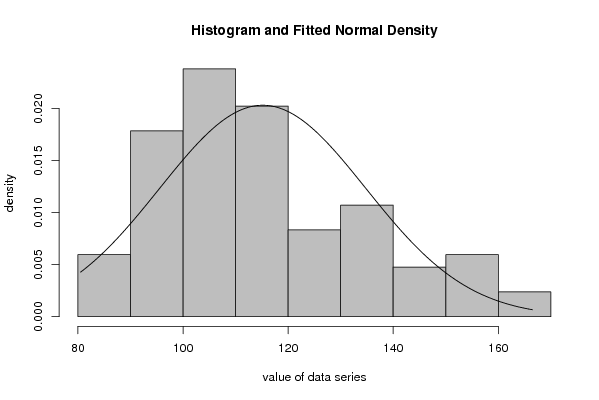Free Statistics
of Irreproducible Research!
Description of Statistical Computation | |||||||||||||||||||||||||||||||||||||||
|---|---|---|---|---|---|---|---|---|---|---|---|---|---|---|---|---|---|---|---|---|---|---|---|---|---|---|---|---|---|---|---|---|---|---|---|---|---|---|---|
| Author's title | |||||||||||||||||||||||||||||||||||||||
| Author | *Unverified author* | ||||||||||||||||||||||||||||||||||||||
| R Software Module | rwasp_fitdistrnorm.wasp | ||||||||||||||||||||||||||||||||||||||
| Title produced by software | Maximum-likelihood Fitting - Normal Distribution | ||||||||||||||||||||||||||||||||||||||
| Date of computation | Tue, 11 Nov 2008 04:28:03 -0700 | ||||||||||||||||||||||||||||||||||||||
| Cite this page as follows | Statistical Computations at FreeStatistics.org, Office for Research Development and Education, URL https://freestatistics.org/blog/index.php?v=date/2008/Nov/11/t1226402922v4pqfba70dy9jnd.htm/, Retrieved Sun, 19 May 2024 09:21:09 +0000 | ||||||||||||||||||||||||||||||||||||||
| Statistical Computations at FreeStatistics.org, Office for Research Development and Education, URL https://freestatistics.org/blog/index.php?pk=23330, Retrieved Sun, 19 May 2024 09:21:09 +0000 | |||||||||||||||||||||||||||||||||||||||
| QR Codes: | |||||||||||||||||||||||||||||||||||||||
|
| |||||||||||||||||||||||||||||||||||||||
| Original text written by user: | |||||||||||||||||||||||||||||||||||||||
| IsPrivate? | No (this computation is public) | ||||||||||||||||||||||||||||||||||||||
| User-defined keywords | |||||||||||||||||||||||||||||||||||||||
| Estimated Impact | 173 | ||||||||||||||||||||||||||||||||||||||
Tree of Dependent Computations | |||||||||||||||||||||||||||||||||||||||
| Family? (F = Feedback message, R = changed R code, M = changed R Module, P = changed Parameters, D = changed Data) | |||||||||||||||||||||||||||||||||||||||
| F [Maximum-likelihood Fitting - Normal Distribution] [Maximum-likelihoo...] [2008-11-11 11:28:03] [3b916296c2d2371d528ff188880e3d2b] [Current] F PD [Maximum-likelihood Fitting - Normal Distribution] [histogram] [2008-11-12 18:59:17] [762cc4d66bc29c3c2c407be34c6d0239] F D [Maximum-likelihood Fitting - Normal Distribution] [maximum-likelihoo...] [2008-11-13 16:13:29] [0e5eff269cdcaf8789c45b6ee36b0c3d] | |||||||||||||||||||||||||||||||||||||||
| Feedback Forum | |||||||||||||||||||||||||||||||||||||||
Post a new message | |||||||||||||||||||||||||||||||||||||||
Dataset | |||||||||||||||||||||||||||||||||||||||
| Dataseries X: | |||||||||||||||||||||||||||||||||||||||
93,5 94,7 112,9 99,2 105,6 113 83,1 81,1 96,9 104,3 97,7 102,6 89,9 96 112,7 107,1 106,2 121 101,2 83,2 105,1 113,3 99,1 100,3 93,5 98,8 106,2 98,3 102,1 117,1 101,5 80,5 105,9 109,5 97,2 114,5 93,5 100,9 121,1 116,5 109,3 118,1 108,3 105,4 116,2 111,2 105,8 122,7 99,5 107,9 124,6 115 110,3 132,7 99,7 96,5 118,7 112,9 130,5 137,9 115 116,8 140,9 120,7 134,2 147,3 112,4 107,1 128,4 137,7 135 151 137,4 132,4 161,3 139,8 146 166,5 143,3 121 152,6 154,4 154,6 158 | |||||||||||||||||||||||||||||||||||||||
Tables (Output of Computation) | |||||||||||||||||||||||||||||||||||||||
| |||||||||||||||||||||||||||||||||||||||
Figures (Output of Computation) | |||||||||||||||||||||||||||||||||||||||
Input Parameters & R Code | |||||||||||||||||||||||||||||||||||||||
| Parameters (Session): | |||||||||||||||||||||||||||||||||||||||
| par1 = 8 ; par2 = 0 ; | |||||||||||||||||||||||||||||||||||||||
| Parameters (R input): | |||||||||||||||||||||||||||||||||||||||
| par1 = 8 ; par2 = 0 ; | |||||||||||||||||||||||||||||||||||||||
| R code (references can be found in the software module): | |||||||||||||||||||||||||||||||||||||||
library(MASS) | |||||||||||||||||||||||||||||||||||||||





